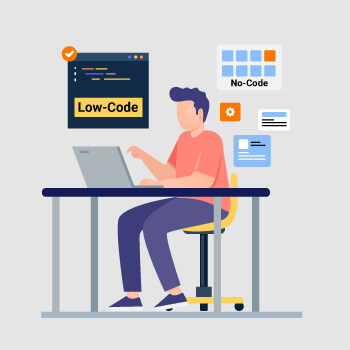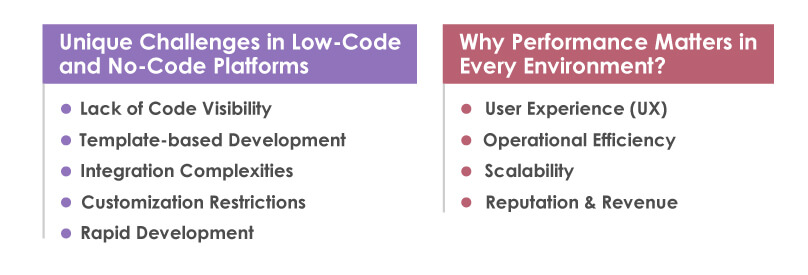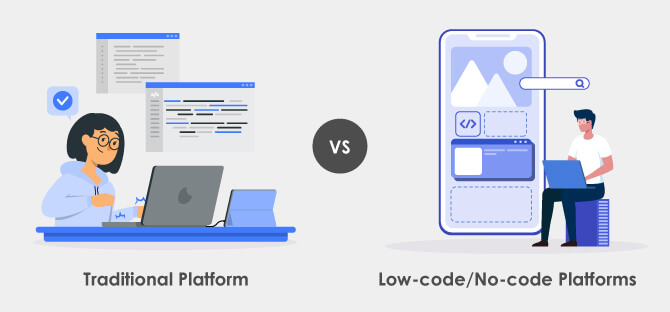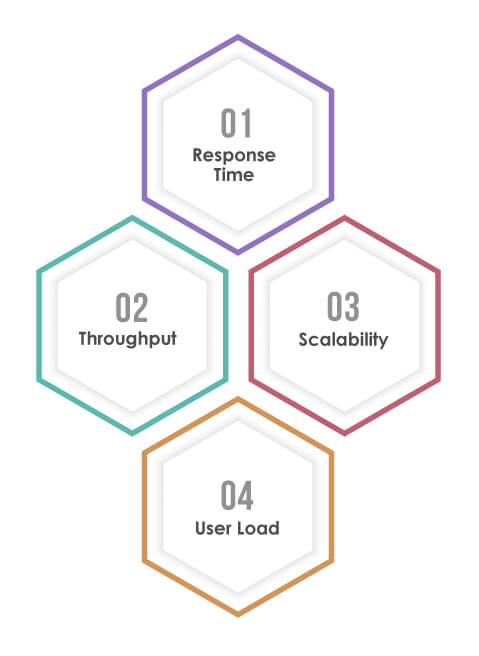
The technological world is ever evolving, and Low-Code and No-Code platforms have made a significant impact in the area of software development. These platforms have supported software development, enabling individuals to build functional and efficient applications regardless of their coding expertise. By providing visual development tools and pre-built components, Low-code/No-code platforms empower users to focus on solving problems and creating value rather than struggling with code.
While these platforms have made software development easy and accessible to non-developers, they introduce new challenges. One of the most pressing concerns is performance. Can applications developed on Low-code/No-code platforms match the performance of traditionally coded ones? It has become a pivotal question for many organizations considering a Low-code/No-code approach. And the answer to this question is “Low-code/No-code performance testing.”
What is a No-code or Low-code Environment?

Low-Code and No-Code platforms allow software creation and deployment without extensive manual coding. While Low-Code environments require some traditional coding, No-Code platforms enable complete app development without writing a single line of code. By reducing the need for manual coding, these platforms significantly speed up the development process, allowing businesses to deploy solutions faster and adapt to changing user needs more efficiently.
The Importance of Performance Testing

Businesses continuously seek ways to develop software faster, cheaper, and more efficiently, and low-code/no-code offers the perfect solution. However, with convenience comes challenges, especially in terms of performance.
Unique Challenges in Low-Code and No-Code Platforms
Low-code and no-code platforms bring about unique challenges that make performance testing even more vital:
Lack of Code Visibility
The basis of low-code/no-code platforms is that they abstract the underlying code, making it more user-friendly. However, this abstraction also means developers may not be aware of inefficiencies in the automatically generated code.
Template-based Development
Many platforms leverage templates to speed up the development process. While templates are efficient, they carry unnecessary code structures that can affect performance.
Integration Complexities
Low-code and no-code platforms often integrate with other systems or platforms. These integrations can introduce latency, especially if not optimized.
Customization Restrictions
Unlike traditional development environments where developers can optimize every aspect of the code, low-code and no-code platforms might limit customization, leading to potential performance constraints.
Rapid Development
The development speed in these platforms sometimes means that performance considerations are an afterthought. When you can quickly drag and drop components, there’s a risk of neglecting how these components might interact at a larger scale.
Why Performance Matters in Every Environment?
User Experience (UX)
Regardless of the platform or tool used to create an application, the end user’s experience remains paramount. Slow apps can lead to decreased user satisfaction and engagement. A study once showed that 53% of mobile users abandon websites that take more than 3 seconds to load. Imagine the abandonment rates for a sluggish application!
Operational Efficiency
Small or low-performing applications can hinder operational efficiency within organizations. Employees may waste valuable time waiting for apps to load or perform tasks, decreasing productivity.
Scalability
An app might work seamlessly when tested with a small user group, but what happens when it’s rolled out to the masses? With performance testing, businesses can avoid encountering scalability issues that can disrupt service.
Reputation & Revenue
A poorly performing app can tarnish a company’s reputation. Customers who can’t rely on your app to function efficiently are less likely to engage with your business or make purchases.
Understanding the Low-Code and No-Code Architecture
At the core of Low-code and No-code architecture lies the concept of abstraction. Abstraction involves simplifying complex technical processes to make them more user-friendly. In Low-Code platforms, developers work with a visual interface to create applications using drag-and-drop components, reducing the need for extensive coding. At the same time, No-code allows non-developers to build applications without coding knowledge.
While these abstractions offer speed and accessibility, they also introduce a layer of complexity that can impact performance. The more layers of abstraction involved, the harder it can be to optimize an application for peak performance. Performance testing becomes essential to ensure that these abstractions don’t lead to sluggish or inefficient applications. Addressing this challenge requires a keen understanding of the underlying architecture and its implications for performance.
Differences in Traditional vs. Low-Code/No-Code Platforms

| Traditional Platform | Low-code/No-code Platforms | |
| Coding Complexity
|
Traditional development involves writing code from scratch, giving developers complete control over every aspect of the application.
|
Low-Code platforms reduce coding complexities, enabling developers to work faster. No-Code platforms take it a step further by eliminating the need for coding. |
| Customization vs. Speed | Traditional development allows highly customized solutions tailored to specific needs. However, this customization often translates to longer development cycles. | Low-Code/No-Code platforms offer speedy development through pre-built components and templates but at the cost of limited customization. |
| Flexibility vs. Constraints | Traditional development offers integration flexibility with any technology or service. | In the Low-Code/No-Code world, integration options might be limited to the platform’s offerings, affecting the application’s overall capabilities. |
| Developer vs. Non-Developer Accessibility | Traditional development primarily involves skilled programmers. | Low-Code platforms extend development possibilities to a broader audience, including those with limited coding expertise. No-Code platforms democratize app creation, allowing anyone to participate. |
Performance Goals for Low-Code/No-Code Platforms

Regarding Low-Code/No-Code platforms, achieving peak performance demands a clear roadmap. Setting specific, measurable performance objectives is the foundation of successful application development. These objectives guide the development process and provide benchmarks to evaluate the application’s efficiency. Performance goals include:
• Achieving a specific response time
• Supporting a defined user load
• Maintaining consistent throughput under varying conditions
Factors to Consider
Response Time
It refers to the application’s response time to a user’s action. It’s a critical factor that directly influences user experience. Slow response times can lead to user frustration and decreased engagement. Performance goals should outline the maximum acceptable response time for different types of interactions within the application.
Throughput
It measures the number of transactions an application can handle within a given time frame. It’s a measure of the application’s efficiency and scalability. Performance goals should define the desired throughput under various usage scenarios to ensure that the application can handle user requests without a dip in performance.
Scalability
It is an application’s ability to handle increased workloads and user loads without compromising performance. Performance goals should address how well the Low-Code/No-Code application can scale up or down based on demand. This is crucial for accommodating growth without disrupting the user experience.
User Load
Understanding the maximum number of users the application can support concurrently is vital. Performance goals should specify the anticipated user load and ensure the application performs optimally during peak usage.
Performance Testing Tips & Techniques

Performance testing is critical to ensuring that applications, whether built using Low-Code or No-Code platforms, meet user expectations for responsiveness and efficiency. As these platforms gain popularity for their rapid development capabilities, it’s crucial to understand how to test and optimize their performance effectively. Let’s look into some tips and techniques for performance testing of Low-code/No-code applications:
Automating Performance Tests
Utilizing tools tailored explicitly for Low-Code/No-Code testing can streamline the process and enhance efficiency. The benefits of automation include repeatability, accuracy, and the ability to simulate a wide range of user interactions. Tools like JMeter and BlazeMeter offer user-friendly features that cater to visual-based development.
Effective Monitoring and Reporting
Monitoring key metrics during performance testing provide insights into the application’s behavior under various loads. Response times, throughput, error rates, and resource utilization are critical metrics to track. Real-time dashboards facilitate immediate feedback, enabling rapid adjustments to optimize application performance.
Optimizing Test Data Management
Data-driven testing demands thorough test data management. Using realistic datasets that mimic production data scenarios is essential. Data masking and pseudonymization techniques also safeguard sensitive information during testing while maintaining data realism.
Ensuring Realistic Test Environments
Mirroring production configurations in test environments is pivotal to accurate performance testing. Replicating hardware, software, and network settings provides that test results closely resemble real-world scenarios. Beware of common pitfalls like underestimating the test environment’s scale or neglecting to account for third-party integrations.
Early Integration of Performance Testing
Don’t wait until the end of the development cycle to start performance testing. Incorporate it from the early stages of development. This approach allows you to identify and address performance issues as they arise, preventing bottlenecks from becoming ingrained in the application.
Scalability Testing
Test the application’s scalability by gradually increasing the load and observing how it handles higher user demands. This practice ensures the application can grow with user requirements without sacrificing performance.
Load Testing with Simulated User Loads
Utilize load testing to assess how well your application performs under various levels of user loads. Simulating expected and unexpected traffic spikes will give you insights into the application’s scalability and help identify performance limitations.
Conclusion
As software development continues to evolve, Low-Code and No-Code platforms are becoming necessary for businesses aiming for agility and swift digital transformation. While promising rapid development cycles, these platforms bring unique challenges, especially regarding performance.
However, they can effectively navigate these challenges with a strategic approach to performance testing and a deep understanding of the architecture and potential bottlenecks. The key lies in proactive monitoring, regular audits, and leveraging built-in and external tools to simulate real-world scenarios. With the right performance test strategies and practices, businesses can harness Low-Code/No-Code platform’s capability without compromising user experience or application efficiency.
Why Choose TestingXperts for Performance Testing?

With years of experience in QA, TestingXperts understands the complexities of Low-Code and No-Code platforms. These platforms speed up app development, but with speed comes the challenge of ensuring top-end performance. Following are some of the reasons to partner with TestingXperts for Low-code and No-code application performance testing:
• Our team understand the root cause, providing sustainable solutions and optimized performance
• Tailored performance testing strategies to specific platforms and business needs
• Simulate real-world user scenarios to see how your app performs in genuine situations
• We constantly monitor app performance, catching and addressing issues in real-time
• Regular updates and clear communication to keep you always in the loop
• Always up-to-date with the latest trends and platform updates
• Our team collaborates with your developers, ensuring seamless communication and shared objective
Contact our experts now to find out more about effective performance-testing solutions.
Discover more
Get in Touch
Stay Updated
Subscribe for more info




